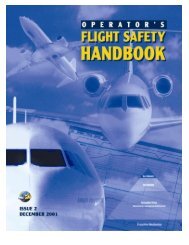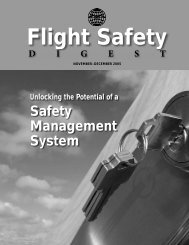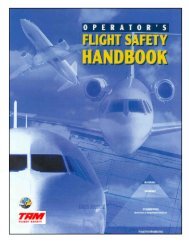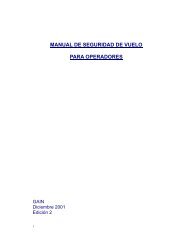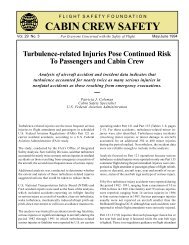Download PDF [10.9 MB] - Flight Safety Foundation
Download PDF [10.9 MB] - Flight Safety Foundation
Download PDF [10.9 MB] - Flight Safety Foundation
Create successful ePaper yourself
Turn your PDF publications into a flip-book with our unique Google optimized e-Paper software.
FLIGHTOPS<br />
authorize 10 demonstration projects<br />
aimed at exploring how remotely piloted<br />
aircraft systems will be integrated<br />
into the aviation community by 2016. 7<br />
The SJU has established a May 31<br />
deadline for demonstration project<br />
proposals, including “integrated preoperational<br />
flight trials activities.” The<br />
projects, which will involve various<br />
types and sizes of remotely piloted air<br />
systems, must be performed in European<br />
Union or Eurocontrol member states<br />
between October 2013 and March 2015.<br />
The EC said the development of<br />
remotely piloted aircraft systems has<br />
“opened a promising new chapter in the<br />
history of aerospace.”<br />
Civil aviation has yet to follow the<br />
military in its widespread use of unmanned<br />
aircraft, the EC said.<br />
When it does, the EC added, unmanned<br />
aircraft “can offer a wide range<br />
of civil applications for the benefit of<br />
European citizens and businesses. …<br />
[The aircraft] can perform tasks that<br />
manned systems cannot perform, either<br />
for safety or for economic reasons.”<br />
Among those tasks are longduration<br />
monitoring, crisis management,<br />
border control, fire fighting and<br />
operations in clouds of volcanic ash,<br />
the EC said. “RPAS can also deliver<br />
profitable commercial aerial services<br />
in various areas, such as in precision<br />
agriculture and fisheries, power or gas<br />
line monitoring, infrastructure inspection,<br />
communications and broadcast<br />
services, wireless communication relay<br />
and satellite augmentation systems,<br />
natural resources monitoring, media<br />
and entertainment, digital mapping,<br />
land and wildlife management, [and]<br />
air quality control and management.”<br />
‘Less Onerous’<br />
In Australia, the Civil Aviation <strong>Safety</strong><br />
Authority (CASA) is planning the<br />
gradual implementation of regulations<br />
for remotely piloted aircraft.<br />
Regulations will be proposed for<br />
different categories of remotely piloted<br />
aircraft, and authorities are considering<br />
simplifying the certification process for<br />
those that will be used in less complex<br />
and less risky operations. In many<br />
instances, non-binding guidance material<br />
will be introduced first, followed by<br />
adoption of regulations, CASA said.<br />
In a February speech to the Association<br />
for Unmanned Vehicle Systems<br />
Australia, Director of Aviation <strong>Safety</strong><br />
John McCormick said that — because 90<br />
percent of the remotely piloted aircraft<br />
operated in Australia weigh less than<br />
7 kg (15 lb) and because of their many<br />
capabilities — “it is impossible for CASA<br />
to effectively regulate all of them.”<br />
Instead, McCormick said, “we have<br />
to address the current reality. There is<br />
no point in CASA writing regulations<br />
that can’t be enforced. … Consequently,<br />
CASA is now looking at introducing<br />
a weight limit to make it less onerous<br />
for commercial operators to use small<br />
remotely piloted aircraft.”<br />
The agency’s goal is to emphasize<br />
safety throughout the development of<br />
new regulations, McCormick said.<br />
“This means ensuring the safety<br />
of any other airspace user, as well as<br />
the safety of persons and property on<br />
the ground,” he said. “Development<br />
of the complete regulatory framework<br />
for remotely piloted aircraft will be a<br />
lengthy effort. This is not a knee-jerk<br />
reaction, it is an evolutionary process,<br />
with regulations being added or<br />
amended gradually.”<br />
26 | FLIGHT SAFETY FOUNDATION | AEROSAFETYWORLD | MAY 2013<br />
Notes<br />
1. ICAO. Unmanned Aircraft Systems (UAS),<br />
Cir 328. 2011.<br />
2. Oklahoma Governor’s Unmanned<br />
Aerial Systems Council. A Strategic Plan<br />
for the Development of an Unmanned<br />
Aerial Systems Enterprise in the State of<br />
Oklahoma. 2012.<br />
3. Governor’s Communications Office.<br />
“Ohio Launches One-Stop Shop for<br />
Unmanned Aircraft Efforts.” .<br />
4. Jenkins, Darryl; Vasigh, Bijan. The<br />
Economic Impact of Unmanned Aircraft<br />
Systems Integration in the United States. A<br />
special report prepared at the request of<br />
AUVSI. March 2013.<br />
5. ACLU. Blog of Rights: Domestic Drones.<br />
.<br />
6. AUVSI. “AUVSI Joins New Coalition to<br />
Promote Innovation, Jobs and <strong>Safety</strong>.”<br />
.<br />
7. EC. “Aeronautic Industries: Remotely<br />
Piloted Aircraft Systems (RPAS).” .<br />
© Boeing


![Download PDF [10.9 MB] - Flight Safety Foundation](https://img.yumpu.com/18550968/28/500x640/download-pdf-109-mb-flight-safety-foundation.jpg)

![Download this Issue [PDF 7 MB] - Flight Safety Foundation](https://img.yumpu.com/18859635/1/190x245/download-this-issue-pdf-7-mb-flight-safety-foundation.jpg?quality=85)
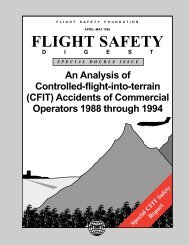
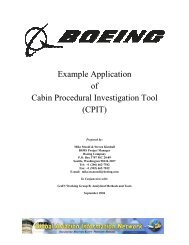
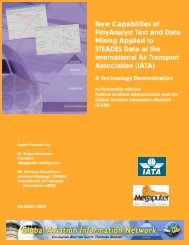
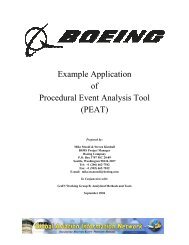
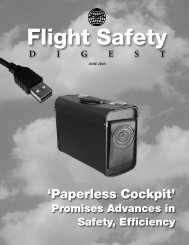
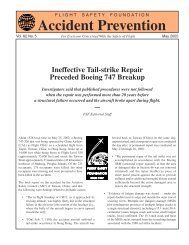
![Download [PDF 8 MB] - Flight Safety Foundation](https://img.yumpu.com/18859366/1/190x245/download-pdf-8-mb-flight-safety-foundation.jpg?quality=85)
